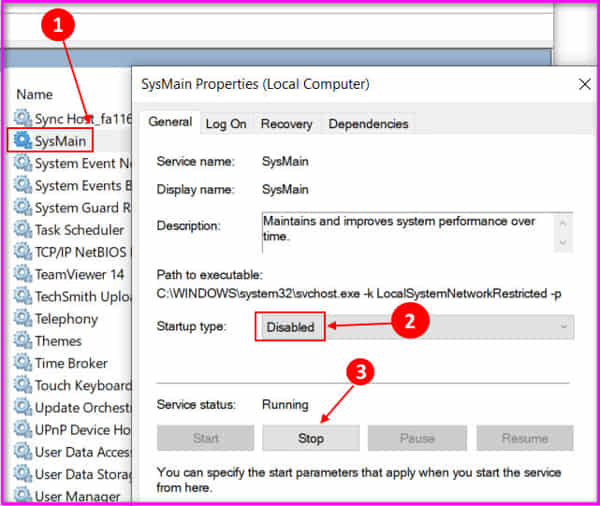It is wise to keep SuperFetch, commonly known as SysMain, operational. Sysmain is a Windows Framework used to monitor and enhance a computer system’s overall performance over time. Due to this service, it will no longer be necessary to deploy apps that you regularly use manually.
SuperFetch is a Windows framework metric that has gone by various names throughout its history. In Windows XP, this function was dubbed Prefetch.
It debuted in Windows Vista and is currently referred to as Sysmain in Windows 10 and Windows Server 2016. Each edition of SuperFetch has had the same goal: to improve Windows speed by preloading frequently used apps into RAM before their use. SuperFetch administration is now referred to as SysMain in the most recent versions of Windows 10.
The Task Manager entry for Service Host: SysMain shows running. This will display in the Task Manager as Service Host: SuperFetch, depending on whether you’re using a more advanced version of Windows 10 or any version of Windows 7 or 8. This assistant runs in the background (using almost little CPU power) and monitors your RAM use and the programs you use the most frequently to make recommendations.
When the help system determines that an application is “often used,” it begins preloading it into the system memory. As a result, the program will operate significantly faster the next time you run it. You might be concerned that this means SuperFetch is consuming all of your RAM, but this is not the case. Support is concentrated on pre-stacking apps into available RAM.
The memory has not been eradicated. Open Task Manager and navigate to the Processes tab to discover how much RAM is utilized by background apps. While Superfetch consumes all available RAM when preloaded apps are run, the total amount of RAM consumed is not 100%. SuperFetch is responsible for this, as it runs in the background and will offer whatever unused RAM it is presently using if you require additional RAM for other dynamic tasks.
Should you disable your SuperFetch?
SuperFetch should not be disabled unless there is a compelling cause to do so. It just requires a small amount of CPU time and uses any unused RAM available.
While most of this passes unseen by the customer, it is essential to note that there have been a few concerns from Microsoft clients who have attended client gatherings that the SuperFetch (Sysmain) measure might cause major execution problems from time to time.
Among the many challenges that have been identified are the following:
- Circular usage of 100 percent consistently.
- The overheating of the framework causes the framework to shut down.
- A considerable amount of time is required for your computer to boot up when you first turn it on.
- The SuperFetch program may take more CPU and RAM than you want on older systems.
- Playing video games has been known to cause issues with execution.
The most often reported problem is the use of 100 percent circular syntax. Alternatively, you can deactivate SuperFetch or Sysmain to remedy the situation. The fact that SuperFetch is a framework enhancement feature means that removing it will have no negative impact on the operation of Windows.
In any case, you may find that starting your most regularly used apps takes a little longer than you had planned.
Is it a good idea to turn off Superfetch?
Superfetch (Sysmain) should be kept up and running as long as you are not having any execution issues or other concerns. Another one of the most beneficial cycles allows you to greatly minimize the time it takes to dispatch apps you use consistently. It is detailed in more significant detail farther down on this page.
SuperFetch may be a good candidate for removal if you’re suffering excessive hard disk use or memory difficulties that persist or if you’re experiencing general lousy performance in any way.
How to Disable Superfetch (Sysmain) In Windows 11
Superfetch is a feature in Windows 10 and 11 that was included for two reasons. The first one shortens the time it takes for the computer to start up, while the second one accelerates the loading of programs onto the computer.
Superfetch does this by preloading them into the computer’s memory before use. It also maintains track of your usage patterns, which allows you to make better preloading selections in the future.
For example, if you open Chrome first thing in the early hours, it will preload Chrome. This will allow the app to load more quickly. In contrast, prefetching may become a substantial cause of excessive disk utilization when combined with other applications. The topic of disabling superfetch in the Windows 10 and Windows 11 operating systems is below.
To disable Superfetch (Sysmain) on Windows 11, Select Start & type benefits, and select the Services application from the drop-down menu. Alternatively, you may press Windows + R and type services.MSc, followed by pressing Enter.
Look for SysMain in the Services application’s list of services, right-click on the help, and pick Stop from the menu. If you’re using a previous version of Windows, you may stop the SuperFetch administrator by right-clicking on it and selecting Stop. It is necessary to prevent the help from continuing when Windows is first booted up at this time.
When the service has been halted, right-click on it once more and pick Properties from the menu that appears.
- Select Disabled as the Startup type from the drop-down menu.
- Superfetch should be disabled using the Registry Editor (Sysmain).
- If you prefer not to use Task Manager to disable Superfetch on Windows 10, you may do it through the use of the Registry Editor.
- You should make a comprehensive backup of your collection before you begin working within the vault, just in case something goes wrong.
Here are the steps to turn off Superfetch/SysMain using the Service Manager interface:
- Look for Services using the Taskbar Search function.
- Select the services that you wish to use.
- A role in the services business is that of a Services Manager.
- Locate and shut off Sysmain if it is present.
- Select Sysmain and double-click on it to activate it.
- In the Startup Type drop-down option that displays, select Disabled as the startup type.
- To end the service, select the Stop option from the drop-down menu.
- Select the Apply button from the drop-down menu.
The Superfecth System has been turned off for the time being.
Disable the Superfetch / Sysmain capability by command
- Log in to the command prompt as an administrator to begin the installation.
- Type the command code supplied below and hit enter in the text field below.
- The line stop=SysMain and start=disabled are included in the sc SystemMain should be stopped, and SystemMain should be installed.
You should remember that you may easily re-enable it by just using the command shown below.
- Starting with sc start SysMain start=auto and ending with sc config SysMain start=auto
- Using the Windows registry, you may turn off the superfetch feature.
- To open the run command box, hit both the Windows key and the R key simultaneously in the first step.
- To begin, type Regedit in the Run command box and click enter to launch the program.
- Complete the third step by going to the address indicated below.
- HKEY LOCAL MACHINE SYSTEM is a key in the machine system. HKEY LOCAL MACHINE SYSTEM is a key in the machine system. CurrentControlSet is the control session manager for the current session. Memory management PrefetchParameters are a set of parameters used to prefetch data from memory. CurrentControlSet is the control session manager for the current session.
- Select Enable Superfetch from the drop-down menu that appears on the right-hand side of the popped-up window.
It is possible to use one of the following values in the EnableSuperfetch variable, depending on your requirements:
- Use a value of 0 to altogether disable Superfetch; a value of 1 to enable prefetching when the program is started. To help prefetching when the application is launched allows for prefetching of all data and information.
Deactivate Superfetch (or Windows Search)
Depending on your operating system, you may be able to take advantage of a feature known as Superfetch, which allows the operating system to “learn” from your usage patterns, recognizing which applications you use the most and preloading them in memory so that they run more quickly the next time you use them.
In any case, this interaction is still taking on behind the scenes, and while it is usually not a cause for concern, it has been demonstrated that it might be when we are using outmoded technology.
SuperFetch should be disabled to ensure that it is not the root of the problem if you are concerned that you have a 100 percent CPU and have successfully proved that the problem does NOT stem from your power supply (force supply). Alternately, go to System Services and choose it from there (or click Start and put “Administrations” into the search box to find it).
A new window has been produced, and it has the ” Sysmain ” help icon, the right snap button, and the properties button (or double-tap straightforwardly). Once the “Startup type” has been presented, the option “Impaired” should be selected in the newly opened box that has appeared. As soon as you acknowledge the prompt, the framework will resume its regular operation.
According to the recommendation, further testing should be done using the “Windows Search” help feature. Even though this is a widespread occurrence, according to the Microsoft Support page, it appears to have been corrected in the most recent versions of Windows.
Disable antivirus software
Thus, turning off or removing your antivirus software will not harm you and will assure that it is not the source of your CPU operating at total capacity all of the time. Antivirus software is known for taking an excessive amount of processor resources when interfering with practically everything that happens on a computer.
In general, as long as Windows Defender is activated and you are not browsing URLs from dubious sources, you should be protected from infection. There is no need to be concerned about running out of antiviral medication.
Identify errors in specific processes
Even though it is somewhat tricky – not confused – this examination will take some time. It may genuinely aid you in identifying why your processor wrenches up to 100 percent for no apparent explanation.
You may use the Windows event watcher to figure out what is causing the processor to run at 100 percent all of the time if you see in the Windows task manager that a cycle labeled Administration Host is causing the processor to run at 100 percent all of the time.
Use the shortcut WIN + R to type eventvwr.MSC, or click the Windows catch and type Occasion watcher to gain access.
Is prefetcher the same as Superfetch
Both services are focused on producing programs at a faster rate than is usually the case. On the other side, Super Fetch stores frequently used programs in RAM to speed up the startup time of new applications. On the contrary, the PreFetcher function is confusing, and Microsoft does not guide how to use it effectively.
These characteristics should not be disabled because they will not provide any substantial benefits in terms of application launch performance, and SSDs are far faster than traditional hard disks.
Occasionally, it is essential to disable Sys Main on Windows 11 PCs with conventional hard disk drives to prevent data loss. However, in the vast majority of cases, it is best to leave it alone.
There will be no problems with your next-generation PC if you utilize SysMain. On the other hand, older personal computers may have different configurations. It is possible to deactivate these services using only two different methods. If you want to turn it off, follow the steps in the opposite direction.
FAQ
Is Superfetch in Windows 11?
SysMain anticipates app launches and preloads data into memory. Its robust prediction algorithm can predict your following three programs and when you’ll start them.
Should I disable SysMain in Windows 11?
It is beneficial to maintain the operation of the SuperFetch, also known as SysMain. Sysmain is a Windows Framework used to monitor and improve system performance over time.



